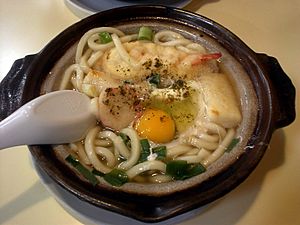Donabe facts for kids
A donabe (Japanese: 土鍋) is a special cooking pot from Japan. Its name means "earthenware pot." These pots are made from a unique type of clay that can be used directly over a flame. Many donabe are made in the Banko ware style, which is known for being very strong against heat.
People often use donabe to cook meals right at the table on a gas burner. This is popular for dishes like nabemono (hot pot meals) such as shabu-shabu or simmering dishes like nabeyaki udon. Donabe pots come in different sizes, measured by a traditional Japanese unit called sun.
Contents
Using and Caring for Your Donabe
Donabe pots are usually smooth and glazed on the inside, but rough and porous on the outside. Even though they are made of clay, like regular earthenware, you can use them over an open flame or in an oven. However, there are a few important things to remember to keep your pot safe and working well:
- Keep it Dry: Always make sure the outside of your donabe is completely dry before you put it on the heat. If there's moisture in the clay, it can expand when heated and might crack the pot.
- Heat Slowly: It's best to heat the pot gradually. This helps prevent cracks that can happen from sudden changes in temperature.
- Don't Leave it Empty: Never leave an empty donabe on a flame. It should always have food or liquid inside when being heated.
When you get a new donabe, or if it hasn't been used for a long time, it's a good idea to prepare it. Some people suggest boiling water in it for a few hours and then letting it dry. Others say you can just fill it with water and let it sit overnight. This helps to seal the pot and make it last longer.
The History of Donabe
Donabe pots are a very old part of Japanese cooking. They are made from a special clay that is porous and coarse. In the area around Iga, a type of donabe called Iga-yaki has been made since 1832. However, Iga-yaki pottery itself has been around since the 7th century and is highly valued. These pots became especially popular during the Edo period (1603-1868).
Making a high-quality donabe can take a long time, sometimes up to two weeks! There are many different styles of donabe, each designed for preparing specific dishes.
Donabe and Community Meals
A special tradition has grown around donabe called "nabe o kakomu." This means "surrounding the pot" and refers to a communal meal where everyone gathers around the donabe to share food. This idea of sharing a meal from one pot is very popular in Japan and has been shown in many cookbooks and TV shows.
The Beauty of Age
As a donabe is used over time, tiny cracks can appear in the glaze on the inside. This is called kannyu. These cracks are not a flaw; instead, they are seen as a sign of the pot's character and history. They show that the pot has been well-loved and used for many delicious meals.
If you take good care of a donabe, it can last for many decades. Some very special ones have even survived for centuries! In old, fancy restaurants in Kyoto, very old donabe pots were sometimes kept and only used for important guests. Newer pots would be used for everyday meals, helping them to "age" and develop their own character over time.
Where Donabe Are Made
Donabe pots are made by skilled potters in different regions of Japan. Some of the most famous places for donabe production include:
- Banko ware
- Iga ware
- Shigaraki ware
- Mashiko ware
The process of making these pots involves kneading the clay, shaping it, and then trimming the vessels. After they are partly dry, handles and knobs are added. They are then dried again, fired in a kiln, glazed, and fired one more time to create the finished pot.
Images for kids
See also
 In Spanish: Donabe para niños
In Spanish: Donabe para niños




